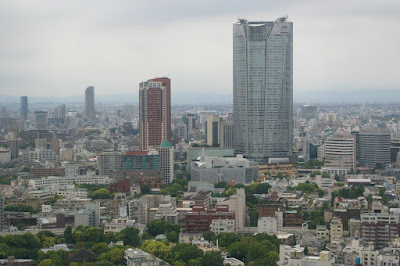
Yesterday I took advantage of what may be one of the last days before the rainy season to walk across Tokyo. Not really across Tokyo, but across the giant Yamanote train line, that runs like a circle, around the center of Tokyo. The Yamanote is the line we ride most of the time. We are staying at Shinagawa, which is about six o'clock on the clockface. Harajuku is ~7:30, Shinjuku is ~9:00, Ikebukuro is 10:30, Ueno is 1:30, Akihabara is about 2:30, Shimbashi is about 4:30. I set out from Shinagawa in the morning, and headed for Nippori, which is about 12:00 on the clock face. Six and a half hours later, I made it to the station there.

I was trying to see some new neighborhoods, take pictures of different cityscapes that seem typical, and see if I could keep my bearings. I got seriously lost twice--once in the center of the city, the government district, where there were few people and few ways to orient oneself, the other time in the residential neighborhoods of the north of Tokyo, where my blisters were beginning to get blisters.

I don't know if these pictures will convey something about the landscape or the city life. One never sees these scenes all the time: it's more as if one is moving through a sequence of different types of scenes. One type: the stark guts of the trainlines (the mass of lines passing through Nippori, above, is one of the big circuit points in the city).

Then there are the cramped neighborhoods where the streets are so narrow one generally need not worry about cars (though the sidewalks are the painted edge of the street, as in the above picture). In general, though Japan has been hit by the recession much worse than the US, central Tokyo doesn't show many signs of that. But this neighborhood, in the north of the city (as you pass from Sendagi to Yanaka) had many shut shops. So it wasn't surprising to see all the political posters above.

These neighborhoods are very beautiful and simple, with older building materials (older meaning probably from the 50s, though a few pre-war buildings are still standing) and parked bicycles...like this barber shop in Sendagi.

And there are the ubiquitous odd signs, often prohibiting something, often using cartoon figures. The one above was outside of what seemed a parking garage: I need to have someone translate the sign, but it seems to be banning men in tuxedos (?!)...

In the middle of the city I came across a giant amusement park on top of some buildings. (Yes, weird...) Above is the ferris wheel, advertised as the first/biggest, center-less ferris wheel in the world.

Also in the center of the city is the Imperial Palace, on a fairly massive plot of land that most people do not have access to. I had to walk around it--I went to the east, where I walked a small park bordering this giant moat.

Nearby is the Diet Building, the parliamentary site. Apart from the cab, you can see how deserted the government area was at this hour. The only places I found, in this middle part of the city, with lots of people were Hibiya Park, full of folks enjoying the weather, and, on a street surrounded by government offices, a massive off-track betting center, drawing hundreds of men from all directions.

One is constantly encountering different textures and styles of of buildings from different moments.

Below is a picture of the annoying set of vans that I kept encountering as I cut across the middle of the city. I first saw these characters outside the Chinese Embassy, where they were blaring a speech and canned music, in Chinese. The signage shows that they are Japanese ultra-nationalists, whose agenda includes complaining about the loss of the pre-1945 empire and military state, while shaking sabers to all Asian neighbors.

I did stumble through a street festival (free popcorn being enjoyed below), another typical Tokyo thing. There are festivals throughout the year, often localized in neighborhoods, as this one, in Azabu, in the south central part of the city.

And in the southern part of the city, you can get your bearings from the Tokyo Tower, though it disappears at times.

Below is the
Sumitomo Fudosan Mita Twin Building, designed by
the Nikken Sekkei firm.

And here, another train yard, featuring the Yamanote Train, the greatest urban train in the world.

And finally, a picture of someone climbing a pedestrian overpass.

 Because of the good weather, we decided to head to Miyajima on the first day in Hiroshima. It's an island off the coast of the city, accessible after a 45-minute trolley ride to the coast. Miyajima is home of one of the most famous toriis in Japanese iconography, the red torii in the water.
Because of the good weather, we decided to head to Miyajima on the first day in Hiroshima. It's an island off the coast of the city, accessible after a 45-minute trolley ride to the coast. Miyajima is home of one of the most famous toriis in Japanese iconography, the red torii in the water. The shrines here date back to the 6th century, and are spread around the island, which is a mountain coming out of the water.
The shrines here date back to the 6th century, and are spread around the island, which is a mountain coming out of the water. 
 The most beautiful temple complex there was the Daisho-in Buddhist temples on the hillside, details of which are below.
The most beautiful temple complex there was the Daisho-in Buddhist temples on the hillside, details of which are below.














































